Analysis of Anti-Vax Graphs
READ THE FULL ENTRY AT SOFTWARE 3D.COM
by Robert Webb
The anti-vaccine movement sometimes presents graphs to support their cause, supposedly to show that diseases were on the decline before vaccines came along, and that vaccines had no effect. Graphs seem hard to argue with. They look scientific, represent actual data, and are compelling to many people. And indeed a good graph should be compelling. But their graphs are not good. Let’s have a look at how the true data, which supports the fact that vaccines have had a huge positive effect, can be manipulated to manufacture the conclusion the anti-vax movement wants.
Death rates
Firstly, most of the graphs they show are of death rates, not infection rates. Yes, death rates dropped significantly before vaccines were introduced because other improvements in medicine and sanitation meant that we were better at treating the disease, but it does not indicate that less people had the disease to begin with.They also tend to show graphs going back a long time to when death rates for common diseases like measles were very high. To fit these high figures on the graph it’s necessary to scale down all the figures, meaning that by the time the vaccine is introduced you can no longer see any drop it may have caused in deaths.
They never show graphs of death rates from third world countries where due to poor sanitation etc. death rates for diseases like measles can still be quite high.
Here’s a nice graph though showing both infection and death rates in the US and it’s clear from both that the 1963 vaccine had a huge effect.
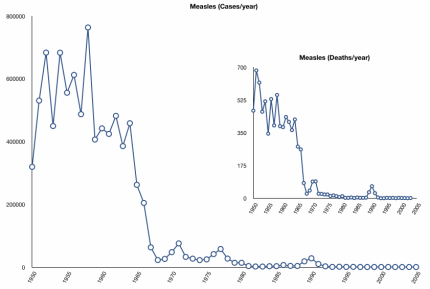
Source: http://www.iayork.com/MysteryRays/2009/09/02/measles-deaths-pre-vaccine/
The anti-vaxxers claim (e.g. here) that death rates are more reliable than infection rates because they don’t trust the diagnoses made by doctors. The idea is that doctors are biased against diagnosing a disease if the patient has been vaccinated against it. But if the symptoms match, why wouldn’t they test for it? We all know that vaccines are not 100% effective. The above graph shows that infection and death rates are very closely matched, year by year, so it seems that the doctors’ diagnoses match the coronors’ reports, so where’s the evidence for this supposed misdiagnosis?
Infection rates
So the best way to see if a vaccine worked is to look at infection rates. I’ve only seen one infection graph presented by the anti-vax side (in several places, but I found it on the AVN website), so let’s look at that in some detail. Here it is: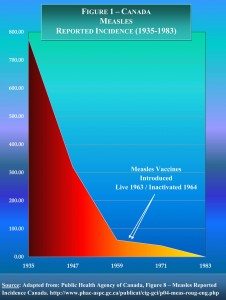
This graph has already been demolished on Science-Based Medicine, so I’ll try not to repeat too much of that, though I need to recap a little. Mostly what I want to show is some new graphs (the big ones further down) that help explain what Dr. Obomsawin did to create the graph he wanted.
Dr. Obomsawin gives his source for the graph as here:

But a better graph of the same data, where actual data points are shown, can be seen in here:
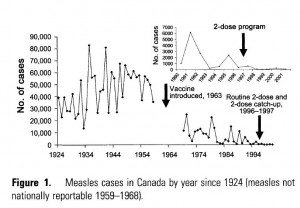
So what’s wrong with the graph?
Here’s some (but not all) of the ways that this graph deceives us.- First, note the slight difference between these last two graphs. The latter graph shows a different point in 1959, before there was a ten year break in national reporting of measles. It appears to be a glitch in the former graph, showing a data point in 1959 when no data is available for that year. My guess is that the graph was made as if all data points were equally spaced, then the ten year gap was inserted, giving the impression that the graph dips down before the introduction of the vaccine, when in fact the dip should be spread across the gap in reporting where the vaccine was introduced. Dr. Obomsawin’s graph makes good use of this non-existence point. I have recreated his graph over the top of the best version of the original graph:
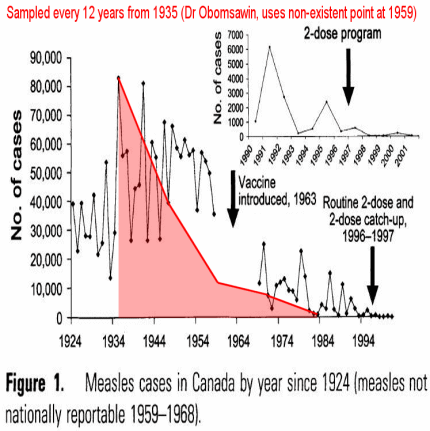
- You’ll also notice immediately that his graph looks nothing like the source graph. This is because he has only used a data point every 12 years. So he has taken a graph with 68 data points, and used only 5 of them! When accused of cherry picking the data, he responds:
- “the data was not selectively “cherry picked”, but rather consistently spaced giving accurate data for every 12th year running from 1935 to 1983, a period which is roughly equivalent to a half century.”
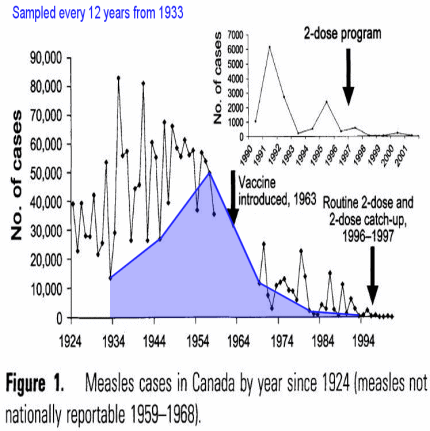
- Yep, it looks completely different, though I’m using exactly the same technique as Dr. Obomsawin to generate this graph from the same original data.
No comments:
Post a Comment
Please keep posts here respectful. Those that cross boundaries will be deleted, and then placed in a special place for future ridicule.